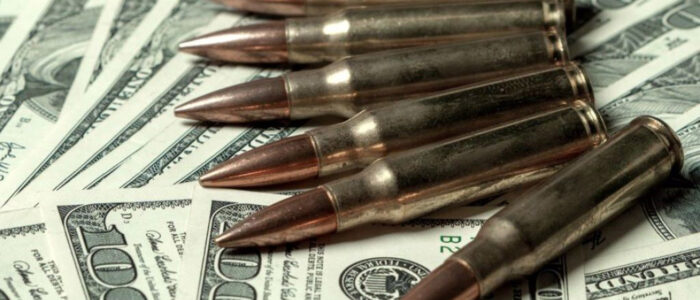Conventional weapons proliferation has been a concern since before the advent of weapons of mass destruction (WMDs). Despite the increased sophistication of the WMDs, conventional weapons remain at the forefront of proliferation concerns. Conventional weapons–broadly defined as all those weapons other than WMDs– include a variety of laser and space weapons, tanks, mortars, mines and autonomous weapons systems, amongst others. As such, they are easier to trade and transfer despite the several conventions and protocols aimed at curbing their spread. Data for the past years indicates the sporadic spread of these conventional arms across the globe. Unchecked proliferation has rendered developing nations more vulnerable. Conflict zones also become all the more unmanageable due to unchecked arms transfer across the globe, which are increasingly linked to grave humanitarian concerns.
Currently, a number of mechanisms exist for the control and responsible trade of conventional weapons. At the global level, most of these mechanisms can be traced back to the United Nations (UN). Among these, the most important international mechanism is the Arms Trade Treaty. It is the major international agreement governing the arms trade. Adopted in 2013 and ratified in the subsequent year, this treaty aims to prevent the use of conventional weapons for human rights abuses and war crimes. It also aims to prevent the illegal and criminal use of conventional weapons. Currently, it has nearly 130 signatories and oversees the responsible transfer and trade of conventional weaponry. Additionally, mechanisms like the UN Register of Conventional Arms (UNROCA) have been put in place to oversee the regulated transfer of arms in order to foster transparency. This register is aimed as a confidence-building measure and has so far been able to trace nearly 90% of the global arms trade.
Other instruments aimed at minimising or transparentising the flow of arms include, for example, the 1980 Convention on Certain Conventional Weapons. This convention contains five additional protocols and is also meant to regulate non-state actors in addition to state actors. Other instruments include the Convention on Cluster Munitions 2008 and the 1997 Convention on the Prohibition of the Use, Stockpiling, Production and Transfer of Anti-Personnel Mines and on their destruction arising out of the Ottawa Declaration. Similarly, The UN Programme of Action on Small Arms and Light Weapons (PoA) is a global framework which addresses the illicit trade of light and small weapons. It relies on the contribution of reports by member states to gauge the effectiveness of implementation mechanisms.
A meaningful conventional arms control is not possible so long as the major powers, also acting as the major arms suppliers, are dismissive of their role in the global trade and transfer of such weapons.
However, the UN alone cannot hope to regulate the flow of weapons through its conventions and instruments. The existence of the veto power in the Security Council and non-binding clauses of most weapons-control instruments means that individual states are essentially free to do as they please so long as they can shoulder the consequences. Therefore, despite such existing mechanisms, limiting and containing conventional arms is a lofty goal in the face of realpolitik and the several benefits arising out of both legal and illicit arms trade. Grey and black arms markets also thrive due to the burgeoning multi-billion-dollar arms industry. Over 1,200 companies in more than 90 countries produce 8M new small arms and light weapons (SALW) annually. A rough estimate placed the financial value of the global arms trade at around $118B in 2019. This billion-dollar industry is not only rooted in economic benefits but is also entrenched in political and strategic planning and policy.
Big powers play a major role in this regard. Russia, US, Germany, France and China act as the major arms suppliers to states around the world. Middle and smaller powers all rely on their trade with one or the other among these states. The presence of a value market is also a decisive factor in the global arms trade. And while smaller powers and developing states act on their own uncertainty arising out of the “anarchical international order”, major powers fuel such arms trade due to their own geopolitical concerns. The result is increasing insecurity in the international order, acted out as a self-fulfilling prophecy. As the figures suggest, this proliferation of conventional arms has resulted in more damage than its non-conventional counterpart. These weapons feature most often in humanitarian crises and asymmetric conflicts around the globe, including terrorism-related incidents. Similarly, the existing mechanisms on arms monitoring and control suffer from certain drawbacks which include, but are not limited to, the problem of information gaps, and compliance with the existing protocols. These problems are exacerbated in conflict zones where illicit trade in arms causes ripple effects for humanitarian crises and political stability.
A meaningful conventional arms control is not possible so long as the major powers, also acting as the major arms suppliers, are dismissive of their role in the global trade and transfer of such weapons. Bloc politics and heightened tensions between these major global arms suppliers point towards not only the lack of responsibility but also the precedence of geopolitical interests over humanitarian concerns. The recent flow of conventional weapons geared at South Asia and Middle East clearly manifests the partisanship involved in the transfer of conventional weapons.
While the requisite international conventions and laws are more or less in place, the trouble lies, as always, with the lack of implementation of such mechanisms. The insecurity in the international order can only be mitigated through deliberate steps taken toward confidence-building. Smaller powers can certainly choose not to engage in the transfer and stockpiling of conventional arms. However, the lead here must be taken by those major powers, which are capable of supplying these weapons and fuel uncertainty due to their political posturing and geopolitical manoeuvring.
